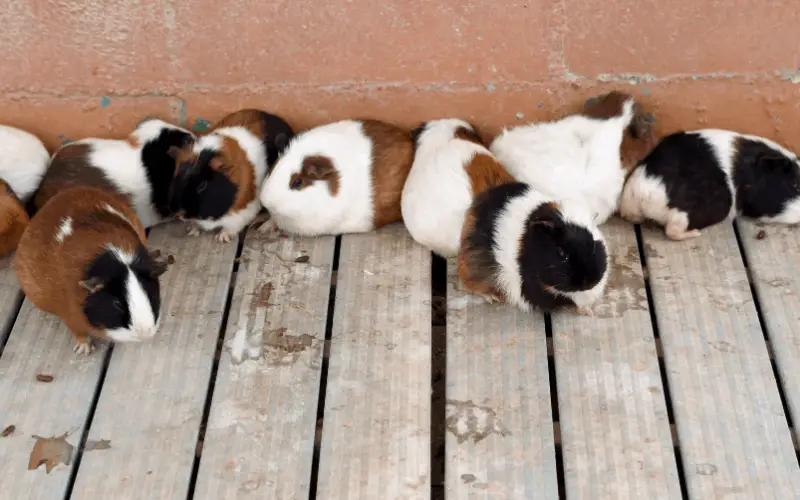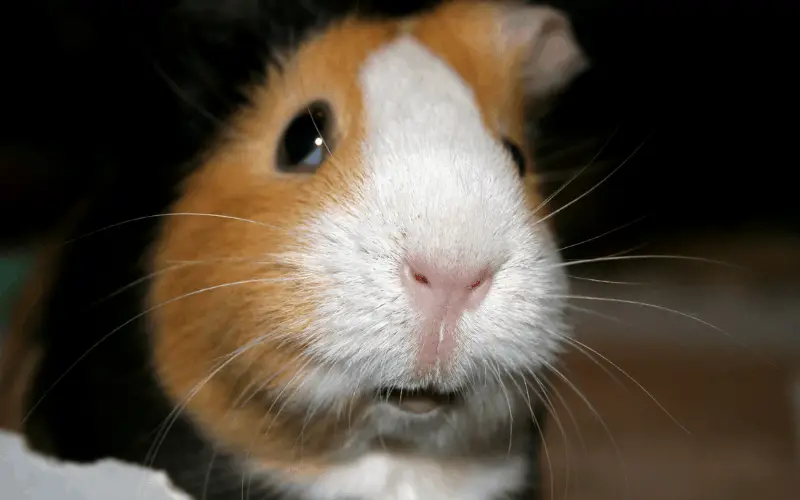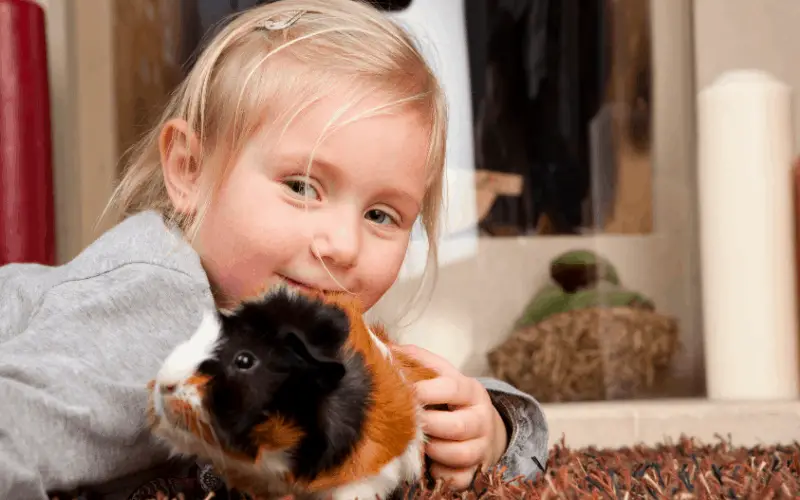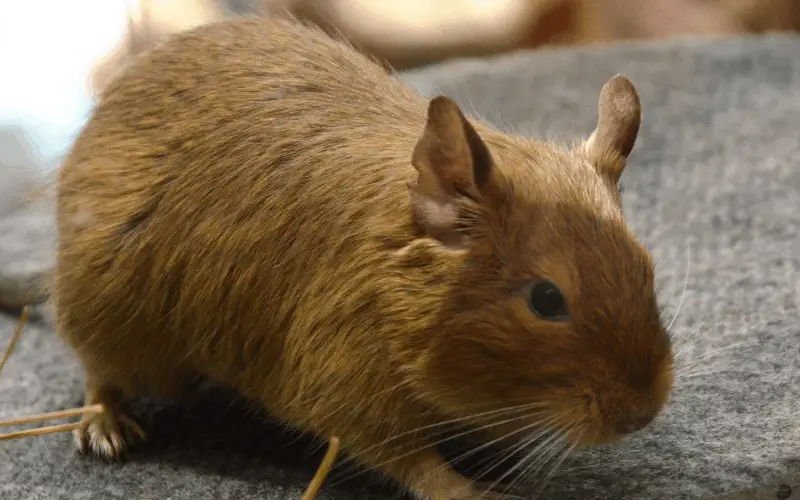As a guinea pig owner, knowing when they are happy is a vital skill as that will help you to understand their behavior at every point in time.
Now, if you have ever wanted to understand when your piggies are sad and happy, this article is for you. I will explain more in-depth how to tell a guinea pig is happy as well as if it’s unhappy.
Let’s get started!
How to Tell a Guinea Pig Is Happy
Just like most animals that people use as pets, your guinea pigs’ general health and other related factors determine their level of happiness. The following few behaviors can tell if your guinea pig is happy:
- Loves to socialize either with humans or other guinea pigs.
- High-pitched squeals
- Deep calm and relaxed purr
- Staying active from time to time
- Popcorning (hoping up in the air)
- Rubbing its nose against its guinea pig friend nose.
Guinea pigs are among some of the most friendly and social animal pets. They love human company, and they naturally depict adoring poises and antics; this makes you truly part of their game.
One of the best things about this pet is that they are relatively easy to maintain. A guinea pig can easily express itself with its owner through specific body language and definite vocal sounds.
If you are always attentive and observant enough, you can easily recognize when your guinea pigs are happy and excited or sad and gloomy.
You can easily find out if they want to play or they just want to mate. They have a way of exhibiting specific behavior, actions, and body postures that make you take the necessary action.
Read Also: How Do I Know if My Guinea Pig Like Me?
Sounds a Happy Guinea Makes

Being an extremely social animal also means that your guinea pig has a way of passing crucial messages, especially when they are happy.
Some of the common indications that the animal is happy are through clear vocal communication, an example of these vocals includes:
1. A High Pitched Squeal
This kind of sound produces a whistling sound, which mostly comes out when the pet is either happy, and just wants to play, or they know it’s feeding time. Given that they love their food so much, whistling is its way of registering their anticipation of a sumptuous meal.
Sometimes it could be a way of their wanting your company, affection or to play. Most often, when you are carrying some food in your hands, or you are opening the fridge or cooking in the kitchen, that kind of squeal becomes evident.
It’s therefore up to you to decipher which is which, and according to the times you have set for each activity.
2. A Deep, Calm and Relaxed Purr
This kind of sound comes out like that of a cat; its type of quiet grunt depicts contentment and comfort. With such, you also recognize that fundamental interactions are just as casual and relaxed in a perfect way. Their posture is also one of calm and friendliness.
3. Body Language of a Happy Guinea Pig
You can quickly get to know your pig by how they communicate using their body language. Here are some examples:
Hopping in the air: This type of jump can also be called popcorning. You can easily perceive that your pet is happy and excited about how they jump up and down.
They do so quite repeatedly, just like popcorns. It’s more of the norm in the very young, who is often quite playful. Even the older ones jump, but with certain limitations, still, it’s a good indicator that they are happy and in their perfect form.
Rubbing the nose: If you have a pair of them, you can see that they occasionally rub their nose against each other; it is a sign of both friendliness and happiness. They can also lick you to show affection.
Socializing: Guinea pigs are known for their friendly social attributes, more when in the company of other guinea pigs. They jump, play, and runs around excitedly. They like to strut their stuff around and make their presence known.
How Do You Know If Your Guinea Pig Is Not Happy?

It is important to understand all the behavioral patterns of your guinea pig. Doing so allows you to know that they are not in their best form.
You can then take remedial actions to bring them back to normal. The list below shows some types of vocal and physical communication of your pet.
Aggressive behavior
One can notice this kind of communication when they try and rise while standing on their two hind legs. This could be accompanied by hissing or chattering sounds; you can also see that they are fluffing out their coat and baring their teeth.
Another sign of aggressiveness is when they are still moving on their stiff hind legs, but from side to side.
Fidgeting or freezing
This is usually an indication that they are either uncomfortable, anxious, or afraid of something.
Depression or stress
Just like any other animal, guinea pigs can also be unhappy and depressed. Things to look out for of such conditions include irritability, reclusiveness, and a particular lack of energy. Your pet may even show a loss of appetite and just not be its usual self at all.
Tossing of their head
Sometimes guinea pigs can be noticed tossing their head in the air. It is a common sign that they do not want to be petted. Instead, they just want to be left alone.
How Can You Make Your Guinea Pig Happy?

There are several ways you can apply to ensure that your guinea pig remains as happy and comfortable as possible. These includes:
Feed Them a Healthy Balanced Diet
The truth is that health matters in the overall happiness of your pet. Feeding them on the prescribed guinea pig balanced diet can make them less predisposed to the disease.
It is also good to consult with a vet to know the exact healthy portions that your pet should consume daily so that it’s not too much to consume, and neither is it too little that they starve.
Spend Some Quality Time Bonding With Them
Being a highly social animal, these pets need some level of a company, whether human or other guinea pigs. If it’s a single pet, you need to cuddle and bond with it as often as possible. They love it when you stroke and pet them.
It’s a kind of reward for them, which makes them happy and relaxed. However, you should not overdo the bonding; a daily 20-30 minutes of affection is more than enough.
These sessions are also an excellent opportunity to carefully check them out and see if they are in their perfect physical condition.
Offer Them Physical and Mental Stimulation
Guinea pigs are naturally active animals. More often than not, they need to release all pent-up energy.
It is essential to add some physical and mental exercises to their daily routine. Otherwise, they can be prone to destructive behavior, or they can also be depressed.
Conclusion
The perfect response to the question, how do I know if my guinea pig is happy, is quite apparent. This is because, judging by their very nature, these pets have straightforward ways of communicating. Whether by vocalization or body language, you able to know how they feel.
Understanding each message and signal they are passing is one of the best ways to meet their daily needs. You can quickly know if they are happy or need some happiness.
